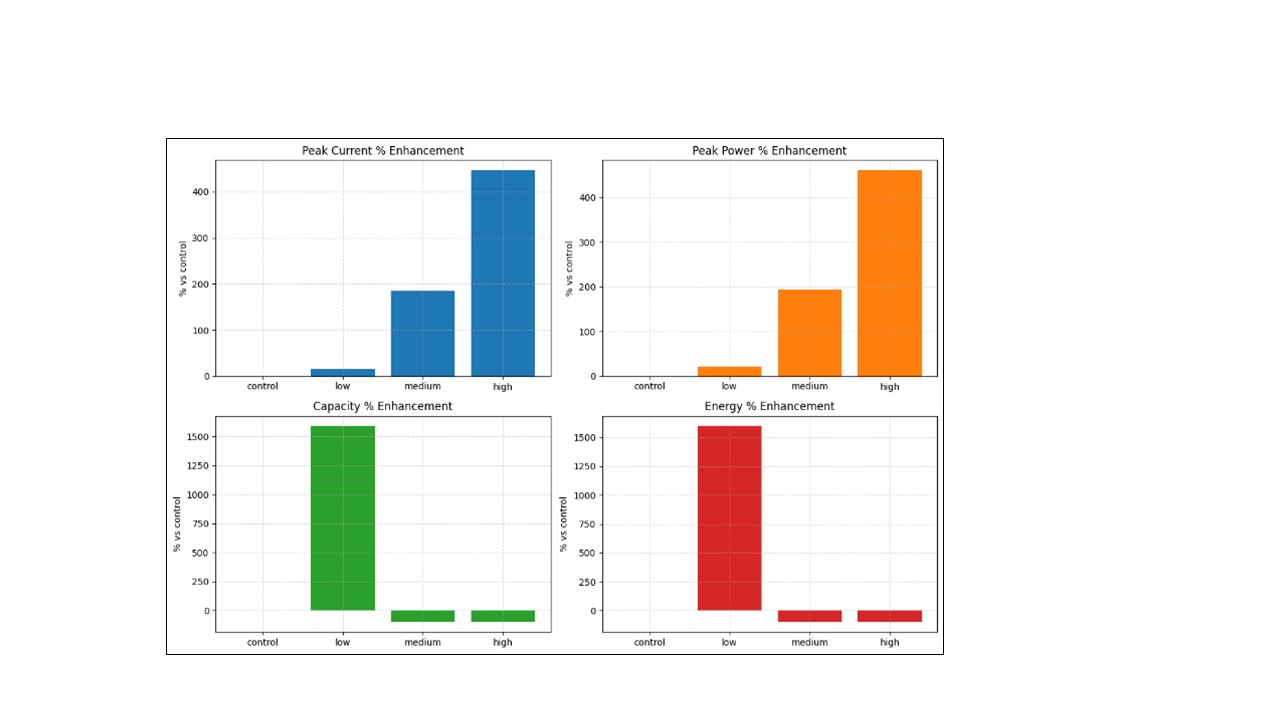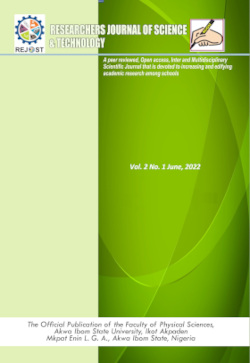Dose-Dependent Irradiation Effects on Lithium–Air Battery Performance
Keywords:
Lithium–air batteries, Irradiation effects, Defect dynamics, Electrochemical performance, Dose-dependent enhancementAbstract
The effect of irradiation dose on the performance of lithium–air batteries was investigated using a coupled electrochemical–defect evolution model. The model describes oxygen and lithium transport, lithium peroxide precipitation, and Butler–Volmer electrochemical kinetics. Irradiation-induced defects are treated as a dynamic variable that modifies diffusivity, exchange current density, and specific surface area through a biphasic mechanism. Numerical simulations were performed under control, low-dose, medium-dose, and high-dose conditions to characterize the full dose-dependent behaviour. The results reveal a nonlinear response. In the control case, current, power, and capacity remain minimal due to slow electrochemical kinetics. Low-dose irradiation enhances reaction activity while preserving transport. This produces modest increases in peak current and power and dramatic gains in capacity and energy that increase by more than 1500% relative to control. Medium and high doses generate sharp current and power spikes, but these are not sustained. In such cases, lithium peroxide formation collapses, capacity and energy drop to nearly zero, and the electrolyte potential diverges as defect densities exceed 10²² m⁻³. The study establishes irradiation as a double-edged influence on lithium–air batteries. At low doses, defects improve kinetics and product formation within an optimal defect window. At higher doses, excessive defects suppress transport and lead to performance failure. The novelty of this work lies in unifying irradiation physics with lithium–air battery modeling, to our knowledge, a biphasic window has not been reported in the Li–air literature. This provides new theoretical insight and practical guidance for the design of irradiation-assisted energy storage systems.
References
Aidhy, D. S., Lu, C., Jin, K., Bei, H., Zhang, Y., Wang, L., & Weber, W. J. (2015). Point defect evolution in Ni, NiFe and NiCr alloys from atomistic simulations and irradiation experiments. Acta Materialia, 99, 69-76. https://doi.org/10.1016/j.actamat.20-15.08.007.
Akhtar, N., & Akhtar, W. (2015). Prospects, challenges, and latest developments in lithium–air batteries. International Journal of Energy Research, 39(3), 303-316. https://doi.org/10.1002/er.3230.
Akintunde, S. O., & Selyshchev, P. A. (2016). The influence of radiation-induced vacancy on the formation of thin-film of compound layer during a reactive diffusion process. Journal of Physics and Chemistry of Solids, 92, 64-69. https://doi.org/10.1016/j.jpcs.2016.01.020.
aAkintunde, S. O., Selyshchev, P. A., & Kehinde, D. O. (2025). Growth Kinetics of Refractory Metal Silicide under Radiation Induced Interstitial Mechanism: An Analytical Approach. BIMA Journal of Science and Technology (2536-6041), 9(1B), 274-282. https://journals.gjbe-academia.com/index.php/bimajst/article/view/958.
bAkintunde, S. O., Selyshchev, P. A., & Kehinde, D. O. (2025). Temperature Variation in an AB Bilayer System During Radiation-Induced AB Compound Layer Formation. FUDMA Journal of Sciences, 9(2), 98-104. https://doi.org/10.33003/fjs-2025-0902-3144.
Amine, K., Kanno, R., & Tzeng, Y. (2014). Rechargeable lithium batteries and beyond: Progress, challenges, and future directions. Mrs Bulletin, 39(5), 395-401. https://doi.org/10.1557/mrs.2014.62.
Bugga, R., Smart, M., Whitacre, J., & West, W. (2007, March). Lithium-ion batteries for space applications. In 2007 IEEE Aerospace Conference (pp. 1-7). IEEE. https://doi.org/10.1109/AERO.2007.352728.
Chowdhury, S. R. (Ed.). (2022). Radiation technologies and applications in materials science. CRC Press. ISBN: 9781000807233.
Fan, Y. (2025). Atomistic Modeling of Microstructural Defect Evolution in Alloys Under Irradiation: A Comprehensive Review. Applied Sciences, 15(16), 9110. https://doi.org/10.3390/app15169110.
Gao, Y., Qiao, F., Hou, W., Ma, L., Li, N., Shen, C., ... & Xie, K. (2023). Radiation effects on lithium metal batteries. The Innovation, 4(4). https://doi.org/10.1016/j.xinn.2023.-100468.
Gittleson, F. S., Jones, R. E., Ward, D. K., & Foster, M. E. (2017). Oxygen solubility and transport in Li–air battery electrolytes: establishing criteria and strategies for electrolyte design. Energy & Environ-mental Science, 10(5), 1167-1179. https://-doi.org/10.1039/C6EE02915A.
Guo, J., Meng, X., Wang, Q., Zhang, Y., Yan, S., & Luo, S. (2024). Advancements in Lithium - Oxygen Batteries: A Compre-hensive Review of Cathode and Anode Materials. Batteries, 10(8), 260. https:/-/doi.org/10.3390/batteries10080260.
He, Y., Chen, Z., & Zhang, Y. (2024). Strategies for improving cathode electrolyte interphase in high-performance dual-ion batteries. Iscience, 27(8). https://doi.org/-10.1016/j.isci.2024.110491.
Huang, X., Li, M., Gao, Y., Park, M. G., Matsuda, S., & Amine, K. (2025). Discharge Rate‐Driven Li2O2 Growth Exhibits Unconventional Morphology Trends in Solid‐State Li‐O2 Batteries. Angewandte Chemie International Edition, 64(37), e202507967. https://-doi.org/10.1002/anie.202507967.
Imanishi, N., Luntz, A. C., & Bruce, P. (Eds.). (2014). The lithium air battery: fundamentals (pp. 1-21). New York: Springer. https://doi.org/10.1007/978-1-4899-8062-5.
Khan, M. H., Tucci, V., Lamberti, P., Longo, R., & Guadagno, L. (2025). Lithium-Based Batteries in Aircraft. Engineering Proceedings, 90(1), 39. https://doi.org/-10.3390/engproc2025090039.
Koettgen, J., Grieshammer, S., Hein, P., Grope, B. O., Nakayama, M., & Martin, M. (2018). Understanding the ionic conductivity maximum in doped ceria: trapping and blocking. Physical Chemistry Chemical Physics, 20(21), 14291-14321. https://doi.org/10.1039-/C7CP08535D.
Kreller, C. R., Valdez, J. A., Holesinger, T. G., Morgan, J., Wang, Y., Tang, M., ... & Uberuaga, B. P. (2019). Massively enhanced ionic transport in irradiated crystalline pyrochlore. Journal of Materials Chemistry A, 7(8), 3917-3923. https://doi.org/10.1039/C8TA10967B.
Kulathuvayal, A. S., & Su, Y. (2023). Ionic transport through the solid electrolyte interphase in lithium-ion batteries: A review from first - principles perspectives. ACS Applied Energy Materials, 6(11), 5628-5645. https://doi.org/10.1021/-acsaem.3c00287.
Lampic, G., Gotovac, G., Geaney, H., & O'Dwyer, C. (2016). Comparing the suitability of Lithium ion, Lithium Sulfur and Lithium air batteries for current and future vehicular applications. arXiv preprint arXiv:1606.06347. https://-doi.org/10.48550/arXiv.1606.06347.
Lee, A., Vörös, M., Dose, W. M., Niklas, J., Poluektov, O., Schaller, R. D., ... & Johnson, C. S. (2019). Photo-accelerated fast charging of lithium-ion batteries. Nature Communications, 10(1), 4946. https://doi.org/10.1038/s41467-019-12863-6.
Li, Q., Zhang, T., Zhang, T., Xue, Z., & Sun, H. (2022). Study on two-phase permeation of oxygen and electrolyte in lithium air battery electrode based on digital twin. Energies, 15(19), 6986. https://doi.-org/10.3390/en15196986.
Liu, T., Vivek, J. P., Zhao, E. W., Lei, J., Garcia-Araez, N., & Grey, C. P. (2020). Current challenges and routes forward for nonaqueous lithium – air batteries. Chemical Reviews, 120(14), 6558-6625. https://doi.org/10.1021/acs.chemrev.9b00545.
Liu, X., Song, X., Zhang, Q., Zhu, X., Han, Q., Liu, Z., ... & Zhao, Y. (2022). Decomposition pathway and stabilization of ether-based electrolytes in the discharge process of Li-O2 battery. Journal of Energy Chemistry, 69, 516-523. https://doi.org/10.1016/j.jechem.2022.01.007.
Lüchtefeld, J., Lee, M. Y., Hemmelmann, H., Wachs, S., Behling, C., Mayrhofer, K. J., ... & Berkes, B. B. (2023). Contribution of electrolyte decomposition products and the effect of temperature on the dissolution of transition metals from cathode materials. ACS Omega, 8(36), 32606-32614. https://doi.org/10.1021/acsomega.3c03173.
Mbayachi, V. B. (2025). Ionic transport mechanisms in inorganic solid electrolytes: Interface, NMR and DNP studies. Next Materials, 8, 100657. https://doi.org/-10.1016/j.nxmate.2025.100657.
Meslin, E., Radiguet, B., & Loyer-Prost, M. (2013). Radiation-induced precipitation in a ferritic model alloy: An experimental and theoretical study. Acta Materialia, 61(16), 6246-6254. https://doi.org/10.1016/-j.actamat.2013.07.008.
Nam, D., Moon, J. H., Jin, Y., Seong, H., Choi, B. E., Na, C. W., ... & Choi, J. (2025). Exploring enhanced capacity in lithium-ion battery anodes: Synthesis and electrochemical evaluation of Zn2GeO4 encapsulated in porous carbon balls via carbonization. Journal of Energy Storage, 107, 114858. https://doi.org/-10.1016/j.est.2024.114858.
Numan-Al-Mobin, A. M., Schmidt, B., Lannerd, A., Viste, M., Qiao, Q., & Smirnova, (2022). Interdigitated cathode–electrolyte architectural design for fast-charging lithium metal battery with lithium oxyhalide solid-state electrolyte. Materials Advances, 3(24), 8947-8957. https://-doi.org/10.1039/D2MA00512C.
Qiu, J., He, D., Sun, M., Li, S., Wen, C., Hattrick-Simpers, J., ... & Cao, L. (2015). Effects of neutron and gamma radiation on lithium-ion batteries. Nuclear Instruments and Methods in Physics Research Section B: Beam Interactions with Materials and Atoms, 345, 27-32. https://doi.org/-10.1016/j.nimb.2014.12.058.
Rahman, M. A., Wang, X., & Wen, C. (2013). High energy density metal-air batteries: a review. Journal of the Electrochemical Society, 160(10), A1759. DOI 10.1149-/2.062310jes.
Rasmidi, R., Duinong, M., & Chee, F. P. (2021). Radiation damage effects on zinc oxide (ZnO) based semiconductor devices–a review. Radiation Physics and Chemistry, 184, 109455. https://doi.org/-10.1016/j.radphyschem.2021.109455.
Reza, A., Yu, H., Mizohata, K., & Hofmann, F. (2020). Thermal diffusivity degradation and point defect density in self-ion implanted tungsten. Acta Materialia, 193, 270-279. https://doi.org/10.48550-/arXiv.1909.13612.
Tan, C., Lyons, D. J., Pan, K., Leung, K. Y., Chuirazzi, W. C., Canova, M., ... & Cao, L. R. (2016). Radiation effects on the electrode and electrolyte of a lithium-ion battery. Journal of Power Sources, 318, 242-250. https://doi.org/10.1016-/j.jpowsour.2016.04.015.
Wandelt, K. (1991). Properties and influence of surface defects. Surface science, 251, 387-395. https://doi.org/10.1016/0039-6028-(91)91021-O.
Was, G. S. (2007). Fundamentals of radiation materials science: metals and alloys. Berlin, Heidelberg: Springer Berlin Heidelberg. https://doi.org/10.1007/978-3-540-49472-0_8.
Weiß, O. J., Gaganidze, E., & Aktaa, J. (2012). Quantitative characterization of microstructural defects in up to 32 dpa neutron irradiated EUROFER97. Journal of nuclear materials, 426(1-3), 52-58. https://doi.org/10.1016/j.jnucmat.2012.03.027.
Yan, X., Zhuang, L., Zhu, Z., & Yao, X. (2021). Defect engineering and characterization of active sites for efficient electrocatalysis. Nanoscale, 13(6), 3327-3345. https://doi.org/10.1039/-D0NR08976A.
Yu, M., Liu, Q., Rao, Y., Wang, H., Liu, P., Li, X., ... & Fang, S. (2025). High energy electron beam irradiation on the electrolyte enables fast-charging of lithium metal batteries with long-term cycling stability. Physical Chemistry Chemical Physics, 27(12), 6064-6071. https://doi.org/-10.1039/D5CP00021A.
Zaidi, S. S. H., & Li, X. (2023). Li–O2/air batteries using ionic liquids – a comprehensive review. Advanced Energy Materials, 13(28), 2300985. https://doi.-org/10.1002/aenm.202300985.
Zhang, X., Hattar, K., Chen, Y., Shao, L., Li, J., Sun, C., ... & Nastasi, M. (2018). Radiation damage in nanostructured materials. Progress in Materials Science, 96, 217-321. https://doi.org/10.1016/j.pmatsci-.2018.03.002.
Zupac, D., Galloway, K. F., Schrimpf, R. D., & Augier, P. (1993). Radiation‐induced mobility degradation in p‐channel double‐diffused metal ‐ oxide‐semiconductor power transistors at 300 and 77 K. Journal of applied physics, 73(6), 2910-2915. https://doi.org/10.1063/1.353021

Downloads
Published
How to Cite
Issue
Section
License
Copyright (c) 2025 Researchers Journal of Science and Technology

This work is licensed under a Creative Commons Attribution-NonCommercial-NoDerivatives 4.0 International License.




